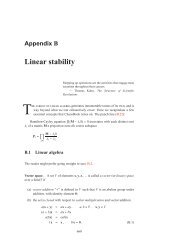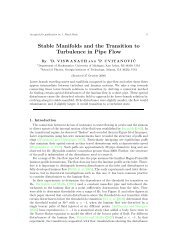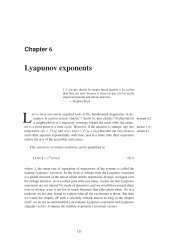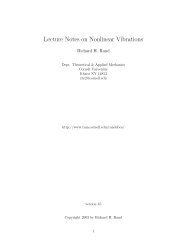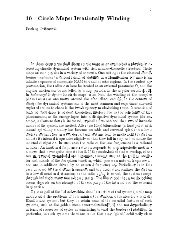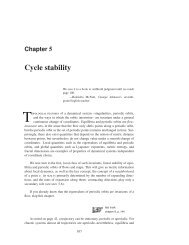CHAPTER 6. LYAPUNOV EXPONENTS 127CHAPTER 6. LYAPUNOV EXPONENTS 128describe the long-time dynamics; these perturbations lie within the subspace spanned bythe leading covariant vectors.That is the first problem with <strong>Lyapunov</strong> <strong>exponents</strong>: stretches{σ j } are not related tothe Jacobian matrix J t eigenvalues{Λ j } in any simple way. The eigenvectors{u ( j) } ofstrain tensor J ⊤ J that determine the orientation of the principal axes, are distinct fromthe Jacobian matrix eigenvectors{e ( j) }. The strain tensor J ⊤ J satisfies no multiplicativesemigroup property such as (4.20); unlike the Jacobian matrix (5.3), the strain tensorJ ⊤r J r for the rth repeat of a prime cycle p is not given by a power of J ⊤ J for the singletraversal of the prime cycle p. Under time evolution the covariant vectors map forwardas e ( j) → J e ( j) (transport of the velocity vector (4.9) is an example). In contrast, theprincipal axes have to be recomputed from the scratch for each time t.If <strong>Lyapunov</strong> <strong>exponents</strong> are not dynamical, why are they invoked so frequently? Onereason is fear of mathematics: the monumental and therefore rarely read Oseledec [6.8,6.9] Multiplicative Ergodic Theorem states that the limits (6.7–6.11) exist for almost allpoints x 0 and vectors ˆn, and that there are at most d distinct <strong>Lyapunov</strong> <strong>exponents</strong>λ i (x 0 )as ˆn ranges over the tangent space. To intimidate the reader further we note in passingthat “moreover there is a fibration of the tangent space T x M, L 1 (x)⊂L 2 (x)⊂···⊂L r (x)=T x M, such that if ˆn∈ L i (x)\ L i−1 (x) the limit (6.7) equalsλ i (x).” Oseledec proofis important mathematics, but the method is not helpful in elucidating dynamics.The other reason to study singular vectors is physical and practical: Lorenz [6.2, 6.3,6.4] was interested in the propagation of errors, i.e., how does a cloud of initial pointsx(0)+δx(0), distributed as a Gaussian with covariance matrix Q(0)=〈δx(0)δx(0) ⊤ 〉,evolve in time? For linearized flow with initial isotropic distribution Q(0)=ǫ1 the answeris given by the left Cauchy-Green strain tensor,Q(t)=〈δx(0) J J ⊤ δx(0) ⊤ 〉= J Q(t) J ⊤ =ǫJ J ⊤ . (6.12)The deep problem with <strong>Lyapunov</strong> <strong>exponents</strong> is that the intuitive definition (6.5) dependson the notion of distance‖δx(t)‖ between two state space points. The Euclidean (orL 2 ) distance is natural in the theory of 3D continuous media, but what the norm should befor other state spaces is far from clear, especially in high dimensions and for PDEs. As wehave shown in sect. 5.3, Floquet multipliers are invariant under all local smooth nonlinearcoordinate transformations, they are intrinsic to the flow, and the Floquet eigenvectors areindependent of the definition of the norm [6.7]. In contrast, the stretches{σ j }, and theright/left principal axes depend on the choice of the norm. Appending them to dynamicsdestroys its invariance.There is probably no name more liberally and more confusingly used in dynamicalsystems literature than that of <strong>Lyapunov</strong> (AKA Liapunov). Singular values/principalaxes of strain tensor J ⊤ J (objects natural to the theory of deformations) and their longtimelimits can indeed be traced back to the thesis of <strong>Lyapunov</strong> [6.10, 6.8], and justlydeserve sobriquet ‘<strong>Lyapunov</strong>’. Oseledec [6.8] refers to them as ‘Liapunov characteristicnumbers’, and Eckmann and Ruelle [6.11] as ‘characteristic <strong>exponents</strong>’. The naturalobjects in dynamics are the linearized flow Jacobian matrix J t , and its eigenvaluesand eigenvectors (stability multipliers and covariant vectors). Why should they also becalled ‘<strong>Lyapunov</strong>’? The Jacobian matrix eigenvectors{e ( j) } (the covariant vectors) areoften called ‘covariant <strong>Lyapunov</strong> vectors’, ‘<strong>Lyapunov</strong> vectors’, or ‘stationary <strong>Lyapunov</strong>basis’ [6.12] even though they are not the eigenvectors that correspond to the <strong>Lyapunov</strong><strong>exponents</strong>. That’s just confusing, for no good reason - the <strong>Lyapunov</strong> paper [6.10] is notabout the linear stability Jacobian matrix J, it is about J ⊤ J and the associated principalaxes. However, Trevisan [6.7] refers to covariant vectors as ‘<strong>Lyapunov</strong> vectors’, andRadons [6.13] calls them ‘<strong>Lyapunov</strong> modes’, motivated by thinking of these eigenvectorsas a generalization of ‘normal modes’ of mechanical systems, whereas by ith ‘<strong>Lyapunov</strong>mode’ Takeuchi and Chaté [6.14] mean{λ j , e ( j) }, the set of the ith stability exponent andthe associated covariant vector. Kunihiro et al. [6.15] call the eigenvalues of stabilitymatrix (4.3), evaluated at a given instant in time, the ‘local <strong>Lyapunov</strong> <strong>exponents</strong>’, andthey refer to the set of stability <strong>exponents</strong> (4.8) for a finite time Jacobian matrix as the‘intermediate <strong>Lyapunov</strong> exponent’, “averaged” over a finite time period. Then there isthe unrelated, but correctly attributed ‘<strong>Lyapunov</strong> equation’ of control theory, which is thelinearization of the ‘<strong>Lyapunov</strong> function’, and there is the ‘<strong>Lyapunov</strong> orbit’ of celestialmechanics, entirely unrelated to any of objects discussed above.In short: we do not recommend that you evaluate <strong>Lyapunov</strong> <strong>exponents</strong>; computestability <strong>exponents</strong> and the associated covariant vectors instead. Cost less and gets youmore insight. Whatever you call your <strong>exponents</strong>, please state clearly how are they beingcomputed. While the <strong>Lyapunov</strong> <strong>exponents</strong> are a diagnostic for chaos, we are doubtfulof their utility as means of predicting any observables of physical significance. This isthe minority position - in the literature one encounters many provocative speculations,especially in the context of foundations of statistical mechanics (‘hydrodynamic’ modes)and the existence of a <strong>Lyapunov</strong> spectrum in the thermodynamic limit of spatiotemporalchaotic systems.Remark 6.2 Matrix decompositions of the Jacobian matrix. A ‘polar decomposition’of a matrix or linear operator is a generalization of the factorization of complex numberinto the polar form, z=r exp(φ). Matrix polar decomposition is explained in refs. [6.16,6.17, 6.18, 6.19]. One can go one step further than the polar decomposition (6.2) into aproduct of a rotation and a symmetric matrix by diagonalizing the symmetric matrix bya second rotation, and thus express any matrix with real elements in the singular valuedecomposition (SVD) formJ= R 1 DR 2 ⊤ , (6.13)where D is diagonal and real, and R 1 , R 2 are orthogonal matrices, unique up to permutationsof rows and columns. The diagonal elements{σ 1 ,σ 2 ,...,σ d } of D are the singularvalues of J.Though singular values decomposition provides geometrical insights into how tangentdynamics acts, many popular algorithms for asymptotic stability analysis (computing<strong>Lyapunov</strong> spectrum) employ another standard matrix decomposition, the QR scheme [6.20],through which a nonsingular matrix J is (uniquely) written as a product of an orthogonaland an upper triangular matrix J=QR. This can be thought as a Gram-Schmidt decompositionof the column vectors of J. The geometric meaning of QR decomposition is thatthe volume of the d-dimensional parallelepiped spanned by the column vectors of J has avolume coinciding with the product of the diagonal elements of the triangular matrix R,whose role is thus pivotal in algorithms computing <strong>Lyapunov</strong> spectra [6.21].Remark 6.3 Numerical evaluation of <strong>Lyapunov</strong> <strong>exponents</strong>. There are volumes of literatureon numerical computation of the <strong>Lyapunov</strong> <strong>exponents</strong>, see for example refs. [6.22,6.11, 6.23, 6.24]. For early numerical methods to compute <strong>Lyapunov</strong> vectors, see refs. [6.25,6.26]. The drawback of the Gram-Schmidt method is that the vectors so constructedare orthogonal by fiat, whereas the stable/unstable eigenvectors of the Jacobian matrixare in general not orthogonal. Hence the Gram-Schmidt vectors are not covariant,<strong>Lyapunov</strong> - 12aug2013 <strong>ChaosBook</strong>.<strong>org</strong> version15.6, Mar 15 2015<strong>Lyapunov</strong> - 12aug2013 <strong>ChaosBook</strong>.<strong>org</strong> version15.6, Mar 15 2015
EXERCISES 129REFERENCES 130i.e., the linearized dynamics does not transport them into the eigenvectors of the Jacobianmatrix computed further downstream. For computation of covariant vectors, seerefs. [6.27, 6.28].6.3 ExamplesThe reader is urged to study the examples collected here. To return back to themain text, click on [click to return] pointer on the margin.Example 6.1 <strong>Lyapunov</strong> exponent. Given a 1-dimensional map, consider observableλ(x)=ln| f ′ (x)| and integrated observable∑n−1∏n−1A(x 0 , t)= ln|f ′ (x k )|=ln∣ f ′ (x k )∣∣∣∣ ∣∣ = ln ∂ f n∂x (x 0)∣ .k=0k=0The <strong>Lyapunov</strong> exponent is the average rate of the expansion1∑n−1λ(x 0 )= lim ln|f ′ (x k )|.n→∞ nk=0See sect. 6.2 for further details.ues. (Christov et al. [?])6.3. How unstable is the Hénon attractor?(a) Evaluate numerically the <strong>Lyapunov</strong> exponentλ byiterating some 100,000 times or so the Hénon map[ ] [ ]x′ 1−axy ′ =2 + ybxfor a=1.4, b=0.3.(b) Would you describe the result as a ’strange attractor’?Why?(c) How robust is the <strong>Lyapunov</strong> exponent for theHénon attractor? Evaluate numerically the <strong>Lyapunov</strong>exponent by iterating the Hénon map fora=1.39945219, b=0.3. How much do you nowtrust your result for part (a) of this exercise?(d) Re-examine this computation by plotting the iterates,and erasing the plotted points every 1000 iteratesor so. Keep at it until the ’strange’ attractorvanishes like the smile of the Chesire cat. Whatreplaces it? Do a few numerical experiments toestimate the length of typical transient before thedynamics settles into this long-time attractor.(e) Use your Newton search routine to confirm existenceof this attractor. Compute its <strong>Lyapunov</strong> exponent,compare with your numerical result fromabove. What is the itinerary of the attractor.(f) Would you describe the result as a ’strange attractor’?Do you still have confidence in claims suchas the one made for the part (b) of this exercise?6.4. Rössler attractor <strong>Lyapunov</strong> <strong>exponents</strong>.(a) Evaluate numerically the expanding <strong>Lyapunov</strong> exponentλe of the Rössler attractor (2.27).(b) Plot your own version of figure 6.3. Do not worryif it looks different, as long as you understand whyyour plot looks the way it does. (Remember thenonuniform contraction/expansion of figure 4.3.)(c) Give your best estimate ofλ e . The literature givessurprisingly inaccurate estimates - see whetheryou can do better.(d) Estimate the contracting <strong>Lyapunov</strong> exponentλ c .Even though it is much smaller thanλ e , a glanceat the stability matrix (4.31) suggests that you canprobably get it by integrating the infinitesimal volumealong a long-time trajectory, as in (4.29).Example 6.2 Singular values and geometry of deformations: Suppose we arein three dimensions, and the Jacobian matrix J is not singular (yet another confusingusage of word ‘singular’), so that the diagonal elements of D in (6.13) satisfyσ 1 ≥σ 2 ≥σ 3 > 0. Consider how J maps the unit ballS={x∈R 3 | x 2 = 1}. V is orthogonal(rotation/reflection), so V ⊤ S is still the unit sphere: then D mapsSonto ellipsoid ˜S={y∈R 3 | y 2 1 /σ2 1 + y2 2 /σ2 2 + y2 3 /σ2 3= 1} whose principal axes directions - y coordinates -are determined by V. Finally the ellipsoid is further rotated by the orthogonal matrix U.The local directions of stretching and their images under J are called the right-hand andleft-hand singular vectors for J and are given by the columns in V and U respectively:it is easy to check that Jv k =σ k u k , if v k , u k are the k-th columns of V and U. click to return: p. ??References[6.1] I. Goldhirsch, P. L. Sulem, and S. A. Orszag, Stability and <strong>Lyapunov</strong> stabilityof dynamical systems: A differential approach and a numerical method,Physica D 27, 311 (1987).[6.2] E. N. Lorenz, A study of the predictability of a 28-variable atmosphericmodel, Tellus 17, 321 (1965).[6.3] E. N. Lorenz, Irregularity: a fundamental property of the atmosphere*,Tellus A 36, 98 (1984).Exercises6.1. Principal stretches. Consider dx= f (x 0 + dx 0 )−f (x 0 ), and show that dx=Mdx 0 + higher order termswhen‖dx 0 ‖ ≪ 1. (Hint: use Taylor expansion fora vector function.) Here,‖dx 0 ‖ ≡ √ dx 0· dx 0 is thenorm induced by the usual Euclidean dot (inner) product.Then let dx 0 = (dl)e i and show that‖dx 0 ‖=dl and‖dx‖=σ i dl. (Christov et al. [?])[6.4] S. Yoden and M. Nomura, Finite-time <strong>Lyapunov</strong> stability analysis and itsapplication to atmospheric predictability, J. Atmos. Sci. 50, 1531 (1993).[6.5] W. G. Hoover and C. G. Hoover, Local Gram–Schmidt and covariant <strong>Lyapunov</strong>vectors and <strong>exponents</strong> for three harmonic oscillator problems, Commun.Nonlinear Sci. Numer. Simul. 17, 1043 (2012),arXiv:1106.2367.[6.6] J. M. Greene and J.-S. Kim, The calculation of <strong>Lyapunov</strong> spectra, PhysicaD 24, 213 (1987).[6.7] A. Trevisan and F. Pancotti, Periodic orbits, <strong>Lyapunov</strong> vectors, and singularvectors in the Lorenz system, J. Atmos. Sci. 55, 390 (1998).6.2. Eigenvalues of the Cauchy-Green strain tensor.Show thatκ i =σ 2 iusing the definition of C, the polardecomposition theorem, and the properties of eigenvalexer<strong>Lyapunov</strong>- 18mar2013 <strong>ChaosBook</strong>.<strong>org</strong> version15.6, Mar 15 2015refs<strong>Lyapunov</strong> - 18apr2013 <strong>ChaosBook</strong>.<strong>org</strong> version15.6, Mar 15 2015



